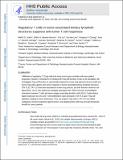Regulatory T Cells in Tumor-Associated Tertiary Lymphoid Structures Suppress Anti-tumor T Cell Responses
Author(s)
Bronson, Roderick T.; Joshi, Nikhil; Akama-Garren, Elliot H.; Lu, Yisi; Lee, Da-Yae; Chang, Gregory; Li, Amy; DuPage, Michel J.; Tammela, Tuomas; Kerper, Natanya R.; Farago, Anna F.; Robbins, Rebecca; Crowley, Denise G.; Jacks, Tyler E.; ... Show more Show less
DownloadJacks_Regulatory t cells.pdf (3.598Mb)
PUBLISHER_CC
Publisher with Creative Commons License
Creative Commons Attribution
Terms of use
Metadata
Show full item recordAbstract
Infiltration of regulatory T (Treg) cells into many tumor types correlates with poor patient prognoses. However, mechanisms of intratumoral Treg cell function remain to be elucidated. We investigated Treg cell function in a genetically-engineered mouse lung adenocarcinoma model and
found Treg cells suppress anti-tumor responses in tumor-associated tertiary lymphoid structures (TA-TLS). TA-TLS have been described in human lung cancers, but their function remains to be determined. TLS in this model were spatially associated with >90% of tumors and facilitated
interactions between T cells and tumor-antigen presenting dendritic cells (DCs). Costimulatory ligand expression by DCs and T cell proliferation rates increased in TA-TLS upon Treg cell depletion, leading to tumor destruction. Thus, we propose Treg cells in TA-TLS can inhibit endogenous immune responses against tumors, and targeting these cells may provide therapeutic benefit for cancer patients.
Date issued
2015-09Department
Massachusetts Institute of Technology. Department of Biology; Koch Institute for Integrative Cancer Research at MITJournal
Immunity
Publisher
Elsevier/Cell Press
Citation
Joshi, Nikhil S. et al. “Regulatory T Cells in Tumor-Associated Tertiary Lymphoid Structures Suppress Anti-Tumor T Cell Responses.” Immunity 43.3 (2015): 579–590.
Version: Author's final manuscript
ISSN
1074-7613
1097-4180